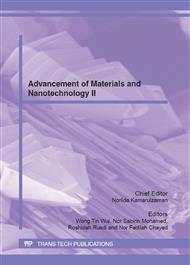p.71
p.76
p.81
p.88
p.93
p.100
p.105
p.111
p.119
The Effects of Temperature of Hydrothermal Growth of Titanium Dioxide Nanomaterial
Abstract:
Titanium dioxide (titania) nanomaterials have been extensively studied for various applications including gas sensor [1], dye-sensitized solar cell [2] and photocatalyst [3]. Titania nanomaterials can be produced using various methods depending on the desired surface morphology. As such the optimization of methods is the key to produce nanomaterials with desired properties where the study here focuses on the effect of autoclaving temperature for the hydrothermal growth. Titania P25 (Degussa, Germany) in 5 M sodium hydroxide solution (NaOH) was treated hydrothermally for 24 hours at 100 °C, 120 °C, 150 °C and 170 °C. Hydrothermal treatment for 24 hours at 150 °C produced nanotubes and treatment at 170 °C produces nanowires. Scanning Electron Microscopy (SEM), Transmission Electron Microscopy (TEM), Energy-dispersive X-ray spectroscopy (EDX) and X-ray Diffraction (XRD) were performed to study the surface and internal morphology of nanomaterials formed. Nanowires produced are of average width of 20 nm and length of 200 nm to 1 µm. Nanotubes produced are average width of 25 nm consisting of multiple walls. Varying the autoclaving temperature will affect the surface morphology of nanomaterials; forming nanotubes at 150 °C and nanowires at 170 °C. Understanding the effect of the process temperature would allow for optimization of the process in order to produce titania nanomaterial with specific characteristics that exhibit enhanced functionality for the development of their applications.
Info:
Periodical:
Pages:
93-99
Citation:
Online since:
July 2012
Price:
Сopyright:
© 2012 Trans Tech Publications Ltd. All Rights Reserved
Share:
Citation:


